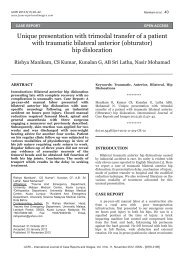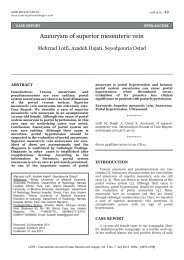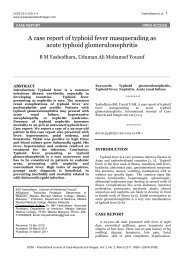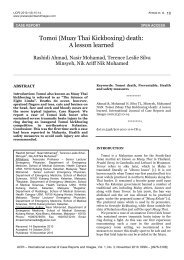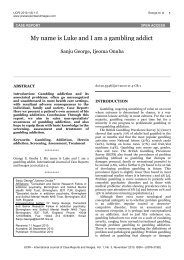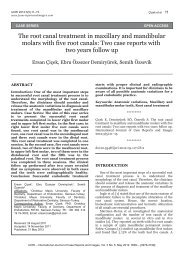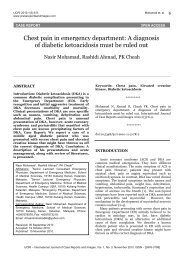Full Text PDF - International Journal of Case Reports and Images ...
Full Text PDF - International Journal of Case Reports and Images ...
Full Text PDF - International Journal of Case Reports and Images ...
You also want an ePaper? Increase the reach of your titles
YUMPU automatically turns print PDFs into web optimized ePapers that Google loves.
IJCRI 201 2;3(5):25–27.<br />
www.ijcasereports<strong>and</strong>images.com<br />
Bohlmann et al. 25<br />
CASE REPORT<br />
OPEN ACCESS<br />
Primary extrahepatic echinococcosis <strong>of</strong> the<br />
right lower abdomen<br />
Ingeborg Bohlmann, Johannes Zitt, Bertram Wagner<br />
ABSTRACT<br />
Introduction: Primary, intraperitoneal<br />
hydatidosis without involvement <strong>of</strong> the liver is a<br />
rare occurrence. Due to vague symptoms,<br />
echinococcosis is <strong>of</strong>ten neglected as a<br />
differential diagnosis. <strong>Case</strong> Report: We present<br />
a case <strong>of</strong> a primary extrahepatic echinoccocal<br />
cyst, located in the peritoneal cavity <strong>and</strong> in<br />
immediate contact to the right psoas muscle.<br />
After initial medical treatment, the cyst was<br />
surgically removed via laparotomy. Parts <strong>of</strong> the<br />
psoas muscle had to be removed due to muscle<br />
invasion <strong>and</strong> as the impairment <strong>of</strong> vena caval<br />
blood flow seemed imminent. Apart from a<br />
minor ventral thigh paraesthesia, the patient<br />
recovered well after surgery. Conclusion:<br />
Imaging <strong>and</strong> serologic tests are described as<br />
st<strong>and</strong>ard tools for diagnosing echinococcosis.<br />
Nevertheless, in uncertain cases, PCR analysis<br />
has proven to be useful. Conservative therapy <strong>of</strong><br />
large intraabdominal echinococcal cysts has<br />
recently gained more interest. However, if the<br />
cyst is located in uncommon areas, surgery is<br />
the treatment <strong>of</strong> choice. Despite advanced<br />
Ingeborg Bohlmann 1 , Johannes Zitt 2 , Bertram Wagner 3<br />
Affiliations: 1<br />
Surgical resident, Department <strong>of</strong> General<br />
Surgery, Asklepios Clinic, Lindau, Germany; 2<br />
Surgical<br />
attendant, Department <strong>of</strong> General Surgery, Asklepios<br />
Clinic, Lindau, Germany; 3<br />
Chief <strong>of</strong> Surgery, Department<br />
<strong>of</strong> General Surgery, Asklepios Clinic, Lindau, Germany.<br />
Corresponding Author: Ingeborg Bohlmann, MD,<br />
Friedrichshafenerstr. 82, 881 31 Lindau, Germany; Ph:<br />
004983822763832, 00436991 81 57736; Fax:<br />
004983822762069; Email: ingeborg.bohlmann@iplace.at<br />
Received: 1 4 September 2011<br />
Accepted: 07 January 201 2<br />
Published: 31 May 201 2<br />
imaging techniques, diagnosing intraabdominal<br />
extrahepatic echinococcosis to be quite<br />
challenging <strong>and</strong> should be included in the<br />
differential diagnosis <strong>of</strong> abdominal pathologies.<br />
Keywords: Echinococcosis, Hydatidosis,<br />
Extrahepatic, Abdominal tumor<br />
*********<br />
Bohlmann I, Zitt J, Wagner B. Primary extrahepatic<br />
echinococcosis <strong>of</strong> the right lower abdomen.<br />
<strong>International</strong> <strong>Journal</strong> <strong>of</strong> <strong>Case</strong> <strong>Reports</strong> <strong>and</strong> <strong>Images</strong><br />
2012;3(5):25–27.<br />
*********<br />
doi:10.5348/ijcri201205120CR5<br />
INTRODUCTION<br />
The predominat forms <strong>of</strong> echinococcosis in humans<br />
are cystic echinococcosis (CE) <strong>and</strong> alveolar<br />
echinococcosis (AE). Primary infection <strong>of</strong> extrahepatic<br />
organs or structures is rare, so far only a few cases have<br />
been reported. The most common route <strong>of</strong> transmission<br />
for EC is oral transmission <strong>and</strong> requires two<br />
mammalian hosts. After ingestion <strong>of</strong> eggs <strong>and</strong> egg<br />
containing segments by a definitive host like dogs or an<br />
aberrant host like humans, the cystic metacestode<br />
develops in internal organs, preferentially in the liver [1,<br />
2].<br />
Intraperitoneal hydatidosis is <strong>of</strong>ten difficult to<br />
diagnose, symptoms are vague <strong>and</strong> are seldom more<br />
specific like an anaphylactic reaction. However, in<br />
intraperitoneal hydatidosis severe complications are<br />
exceptional [3].<br />
We present a case <strong>of</strong> intraabdominal CE without<br />
initial hepatic involvement in a 33yearold gardener.<br />
IJCRI – <strong>International</strong> <strong>Journal</strong> <strong>of</strong> <strong>Case</strong> <strong>Reports</strong> <strong>and</strong> <strong>Images</strong>, Vol. 3 No. 5, May 201 2. ISSN – [0976-31 98]
IJCRI 201 2;3(5):25–27.<br />
www.ijcasereports<strong>and</strong>images.com<br />
Bohlmann et al. 26<br />
CASE REPORT<br />
We like to report a case <strong>of</strong> a 33yearold male with an<br />
indolent palpable mass <strong>of</strong> the right lower abdomen,<br />
initially suspected to be a teratoma. The patient did not<br />
recall any other irregularities, medical history did not<br />
disclose any serious illness.<br />
Aside from a slight tenderness around the mass,<br />
physical examination did not reveal any abnormalities,<br />
Fever was absent <strong>and</strong> laboratory tests were normal.<br />
Computed tomography <strong>and</strong> a previously performed<br />
ultrasound, both affirmed a single septate lesion, partly<br />
cystic, partly solid, without wall calcifications or<br />
daughter cysts. It measured approximately 20x12x11<br />
cm. The inactive part was classified as WHO stage IV,<br />
the active part WHO stage II. The cyst was located in<br />
immediate contact to the psoas muscle. Other crucial<br />
structures seemingly were not affected (Figure 1). There<br />
was no evidence <strong>of</strong> hydatidosis <strong>of</strong> the liver or the lung.<br />
Subsequently, a serologic test showed antibodies against<br />
EC, with a highly positive titre <strong>of</strong> 1:1684.<br />
In cooperation with the department <strong>of</strong> infectiology,<br />
University Hospital Ulm, a therapy with escazole was<br />
started.<br />
Unfortunately, medical treatment did not have any<br />
significant impact on the size <strong>of</strong> the mass. A six month<br />
follow up ultrasound <strong>and</strong> MRI only showed signs <strong>of</strong><br />
regression. As the imaging results arose suspicion <strong>of</strong><br />
involvement <strong>of</strong> vital structures within the lesion <strong>and</strong> the<br />
fact that the patient refused to take eskazole on a long<br />
term basis, it was decided to remove the cyst via<br />
laparotomy.<br />
Intraoperatively, the tumor was extending up to the<br />
psoas muscle <strong>and</strong> the right kidney, already<br />
compromising the inferior vena cava. The distal part <strong>of</strong><br />
the cyst was located within the muscle. Because <strong>of</strong> psoas<br />
muscle involvement small parts <strong>of</strong> the muscle had to be<br />
removed (Figure 2). Histopathological examination<br />
confirmed an echinococcus granulosus cyst that has<br />
been fully extirpated without any scolices (Figure 3).<br />
During the postoperative course the patient<br />
recovered well, neurologic examination did not reveal<br />
any loss <strong>of</strong> motor function. He reported ventral thigh<br />
paraesthesia which was compatible with affection <strong>of</strong> the<br />
lateral femoral cutaneous nerve due to bulky adhesions<br />
<strong>and</strong> muscle invasion in that area.<br />
To present the risk <strong>of</strong> reinfection the patient was<br />
recommended to continue eskazole therapy for four<br />
weeks after the surgery.<br />
Figure 1: A, B) Contrast enhanced axial CT image.<br />
Figure 2: Intraoperative situs during removal <strong>of</strong> the<br />
intramuscular parts <strong>of</strong> the cyst.<br />
DISCUSSION<br />
Primary intraabdominal hydatidosis generally causes<br />
nonspecific symptoms like dull pain or a palpable mass<br />
with a variety <strong>of</strong> differential diagnoses [3, 4]. In this<br />
case, the patient gave a short history <strong>of</strong> abdominal<br />
swelling without any obvious organ dysfunction.<br />
Although major complications are rare, rupture <strong>of</strong> an<br />
Figure 3: Exposed interior <strong>of</strong> the cyst.<br />
IJCRI – <strong>International</strong> <strong>Journal</strong> <strong>of</strong> <strong>Case</strong> <strong>Reports</strong> <strong>and</strong> <strong>Images</strong>, Vol. 3 No. 5, May 201 2. ISSN – [0976-31 98]
IJCRI 201 2;3(5):25–27.<br />
www.ijcasereports<strong>and</strong>images.com<br />
Bohlmann et al. 27<br />
intraperitoneal cyst due to trauma or increased pressure<br />
can be fatal, necessitating emergency surgery [5].<br />
Despite advanced imaging techniques the cyst<br />
formation can be easily mistaken for other pathologies<br />
like abcesses or malignancies, especially when occurring<br />
at uncomon sites. Single cystic lesions are <strong>of</strong>ten difficult<br />
to distinguish from other peritoneal cysts like<br />
mesenteric cysts. Once diagnosed, ultrasonography<br />
seems to be a useful tool for follow up [6].<br />
In our case radiologic imaging suggested an<br />
exp<strong>and</strong>ed teratoma. The CT scan showed a single<br />
heterogenous cyst with intracystic membranes. Typical<br />
attributes like wall attenuation, calcification or<br />
daughter cysts, were absent [7]. Since the patient did<br />
not show any signs <strong>of</strong> infection an abcess was ruled out.<br />
Due to the patient being a gardener by pr<strong>of</strong>ession, a<br />
serological test was performed immediately to arrive at<br />
a quick diagnosis. However, the sensitivity <strong>of</strong> serology<br />
for ED varies, false negative results seem to occur more<br />
likely in cases with unusual locations. Under these<br />
circumstances PCR analysis has proved to be a useful<br />
dignostic method [8, 9].<br />
Although surgery is still the treatment <strong>of</strong> choice,<br />
percutaneous procedures have gained increasing<br />
interest <strong>and</strong> have been used successfully [10]. For EC at<br />
uncommon locations, however, surgery with complete<br />
cyst extraction accompanied by medical treatment is the<br />
preferred method [4, 10].<br />
CONCLUSION<br />
In this case the positive serology lead quickly to a<br />
final diagnosis. Several authors reported the difficulties<br />
<strong>of</strong> relating the diverse clinical features to primary<br />
extrahepatic CE. In endemic areas or in patients with<br />
risk factors (farmers, gardeners) the possibilty <strong>of</strong> CE<br />
should be regarded as a differential diagnosis <strong>of</strong><br />
abdominal pain <strong>and</strong> swelling.<br />
*********<br />
Author Contributions<br />
Ingeborg Bohlmann – Conception <strong>and</strong> design,<br />
Acquisition <strong>of</strong> data, Analysis <strong>and</strong> interpretation <strong>of</strong> data,<br />
Critical revision <strong>of</strong> the article, Final approval <strong>of</strong> the<br />
version to be published<br />
Johannes Zitt – Analysis <strong>and</strong> interpretation <strong>of</strong> dat,<br />
Critical revision <strong>of</strong> the article, Final approval <strong>of</strong> the<br />
version to be published<br />
Bertram Wagner – Analysis <strong>and</strong> interpretation <strong>of</strong> dat,<br />
Critical revision <strong>of</strong> the article, Final approval <strong>of</strong> the<br />
version to be published<br />
Copyright<br />
© Ingeborg Bohlmann et al. 2012; This article is<br />
distributed under the terms <strong>of</strong> Creative Commons<br />
attribution 3.0 License which permits unrestricted use,<br />
distribution <strong>and</strong> reproduction in any means provided<br />
the original authors <strong>and</strong> original publisher are properly<br />
credited. (Please see www.ijcasereports<strong>and</strong>images.com<br />
/copyrightpolicy.php for more information.)<br />
REFERENCES<br />
1. Eckert J, Deplazes P. Biological, epidemiological,<br />
<strong>and</strong> clinical aspects <strong>of</strong> echinococcosis, a zoonosis <strong>of</strong><br />
increasing concern. Clin Microbiolo Rev<br />
2004;17:107–35.<br />
2. Kern P, Bardonnet K, Renner E, et al. European<br />
echinococcosis registry: human alveolar<br />
echinococcosis, europe, 19822000. Emerg Infect<br />
Dis 2003;9:343–9.<br />
3. Sing P, Mushtaq D, Verma N, Mahajan NC. Pelvic<br />
hydatosis mimicking a malignant multicystic ovarian<br />
tumor. Korean J Parasitol 2011;48:263–5.<br />
4. AbuEshy SA. Some rare presentations <strong>of</strong> hydatid<br />
cyst (Echinococcus granulosus). J R Coll Surg Edinb<br />
1998;43:347–2.<br />
5. Kara M, Tihan D, Fersahoglu T, Cavda F, Tititz I.<br />
Biliary peritonitis due to fallen hydatid cyst after<br />
abdominal trauma. J Emerg Trauma Shock<br />
2008;1:53–4.<br />
6. Nell M, Burgkart RH, Gradl G, et al. Primary<br />
extrahepatic alveolar echinococcosis <strong>of</strong> the lumbar<br />
spine <strong>and</strong> the psoas. Ann Clin Microbiol Antimicrob<br />
2011;10:3.<br />
7. Ilica AT, Kocaoglu M, Zeybek N, et al. Extrahepatic<br />
abdominal hydatid disease caused by echinococcus<br />
granulosus: imaging findings. Am J Roentgenol<br />
2007;189(2):337–43.<br />
8. Mathis A, Deplazes P, Kohler P, Eckert J. PCR for<br />
detection <strong>and</strong> characterization <strong>of</strong><br />
parasites(Leishmania, Echinococcus, Microsporodia,<br />
Giardia) Schweiz Arch Tierheilkd 1996;138:133–8.<br />
9. Georges S, Villard O, Filisetti D, et al. Usefulness <strong>of</strong><br />
PCR analysis for diagnosis <strong>of</strong> alveolar echinococcosis<br />
with unusual localizations: two case studies. J Clin<br />
Microbiol 2004 Dec;42(12):5954–6.<br />
10. Yasawy MI, Mohammed AE, Bassam S, Karawi MA,<br />
Sharig S. Percutaneous aspiration <strong>and</strong> drainage with<br />
adjuvant medical therapy for treatment <strong>of</strong> hepatic<br />
hydatid cysts. World J gastroenterol<br />
2011;17:646–50.<br />
Guarantor<br />
The corresponding author is the guarantor <strong>of</strong><br />
submission.<br />
Conflict <strong>of</strong> Interest<br />
Authors declare no conflict <strong>of</strong> interest.<br />
IJCRI – <strong>International</strong> <strong>Journal</strong> <strong>of</strong> <strong>Case</strong> <strong>Reports</strong> <strong>and</strong> <strong>Images</strong>, Vol. 3 No. 5, May 201 2. ISSN – [0976-31 98]



